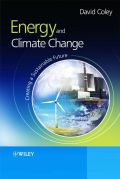
Energy and the Global Environment provides an up-to-date introduction to the subject examining the relationship between energy and our global environment. Energy is placed at the front of a discussion of geo-systems, living systems, technological development and the global environment, enabling the reader to develop a deeper understanding of magnitudes. Learning is re-enforced, and the relevance of the topic broadened, through the use of several conceptual veins running through the book. One of these is an attempt to demonstrate how systems are related to each other through energy and energy flows. Examples being wind-power, and bio-mass which are really solar power via another route; how theenergy used to evaporate sea water must be related to the potential for hydropower; and where a volcano's energy really comes from. With fermi-like problems and student exercises incorporated throughout every chapter, this text will provide the perfect companion to the growing number of students taking an interest in the subject. INDICE: Preface Introduction Part I: Energy: concepts, history and problems Energy What is energy? Units 2. Power Energy in various disguises Energy quality and exergy Student exercises 3. The planets energy balance The sun The earth Comparisons Student exercises 4. A history of humankinds use of energy Energy and society Wealth, urbanization and conflict Our current level of energy use Student exercises 5. Sustainability, climate change and the global environment Sustainability Climate change Other concerns Debating climate change and answering the sceptics Student exercises 6. Economics and the environment Key concepts Environmental economics Student exercises 7. Combustion, inescapable inefficiencies and the generation of electricity Combustion Calorific values Inescapable inefficiencies Heat pumps Double Carnot efficiencies The generationof electricity from heat Student exercises Part II Unsustainable energy technologies 8. Coal History Extraction The combustion of coal Technologies for useExample applications Global resource Student exercises 9. Oil Extraction The combustion of oil Technologies for use Example application: the motor car Global resource Student exercises 10. Gas Extraction The combustion of gas Technologies for use Example application: the domestic boiler Global resource Studentexercises 11. Non-conventional hydrocarbons Oil shale Tar sands Methane hydrate Student exercises 12. Nuclear power Physical basis Technologies for use Environmental concerns Waste World resource Example applications Is nuclear powerthe solution to global warming? Student exercises 13. Hydropower History Technologies for use Example application: Itaipu hydroelectric station Environmental impacts Pumped storage Global resource Student exercises 14. Transport and air quality Present day problems Air quality and health Example application: air quality in Exeter, UK Student exercises 15. Figures and philosophy: an analysis of a nations energy supply The economy Production Consumption Oil and gasproduction Prices Fuel poverty Carbon emissions Sustainable energy in the UK:the current state of play Student exercises Part III Climate change: predictions and policies 16. Future world energy use and carbon emissions The world's future use of energy Student exercises 17. The impact of a warmer world Climate models Natural variability and model reliability Future climate change Impacts Costing the impact Student exercises 18. Politics in the greenhouse: contracting and converging Climate negotiations Another approach Bringing it all together Conclusion Student exercises Part IV Sustainable energy technologies 19.Current world sustainable energy provision Energy efficiency Cogeneration Reducing energy losses Energy recovery Energy efficiency in buildings Student exercises 20. Solar power Passive solar heating Heat pumps Solar water heating Low temperature solar water heating Example application: solar water heating, Phoenix Federal Correction Institution, USA High temperature solar power Low temperature water-based thermal energy conversion OECD resource Student exercises21. Photovoltaics History Basic principles Technologies for use Electrical characteristics Roof-top PV Example application: Doxford Solar Office, UK OECD resource Student exercises 22. Wind power History Technologies for use The modern horizontal axis wind turbine Environmental impacts OECD resource Example application: Harøy Island Wind Farm, Sandøy, Norway Student exercises 23. Wave power Wave characteristics Technologies for use Example application: the Pelamis P-750 wave energy converter Student exercises 24. Tidal and small-scale hydropower Tides Small-scale hydropower OECD resource Student exercises 25. Biomass History Basic principles Technologies for use Example application: anaerobicdigester, Walford College Farm, UK Global resource OECD resource Student exercises 26. Geothermal Background History Resource and technology Technologies for use Environmental problems World resource OECD resource Example application: Hacchobaru geothermal power station, Kokonoe-machi, Japan Student exercises 27. Fast breeders and fusion Fast breeder reactors Fusion Example application:JET Torus, Culham, UK Student exercises Improving energy efficiency 28. Alternative transport fuels and engines Hydrogen powered vehicles and the hydrogen economy Fuel cells Example application: the greening of natural gas Student exercises 29. Carbon sequestration and climate engineering Capture technologies Storage technologies The reflection of solar radiation Example application: Statoil, Sleipner West gas field, North Sea Student exercises 30. A sustainable,low carbon future? Methodology and assumptions Results Worldwide reductions Conclusion What can I do? Student exercises References Appendix 1: National energy data Appendix 2: Answers to in-text problems Appendix 3: Bibliography and suggested reading Appendix 4: Useful data
- ISBN: 978-0-470-85313-9
- Editorial: John Wiley & Sons
- Encuadernacion: Rústica
- Páginas: 600
- Fecha Publicación: 18/04/2008
- Nº Volúmenes: 1
- Idioma: Inglés
